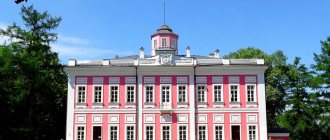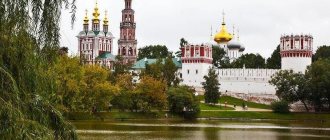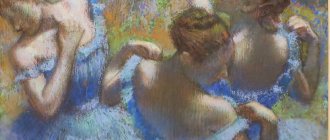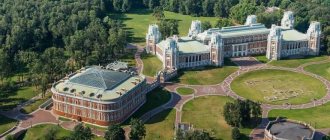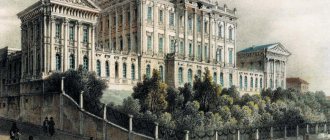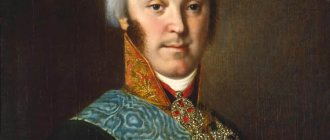The riddle of the name: why is Ascension big?
The Church of the Ascension of the Lord in Storozhi, or Great Ascension, is one of the most famous in Moscow.
It was there that Alexander Pushkin and Natalya Goncharova got married. The word “big” in the name indicates the close proximity to another church - a 17th-century temple located opposite the conservatory (Bolshaya Nikitskaya Street, building 18), called Small Ascension. Restoration was also completed there not long ago. The Church of the Great Ascension (Bolshaya Nikitskaya Street, building 36, building 1) is named in honor of the Ascension of the Lord. The holiday refers to the event described in the Gospel - the ascension of Christ to heaven after the resurrection.
The first church on the site of the current Great Ascension appeared in the middle of the 16th century. Then it was the nearest Moscow region - the temple stood behind the fortress wall of the White City. In the 17th century, the palace of Natalya Kirillovna Naryshkina, the wife of Tsar Alexei Mikhailovich and the mother of Peter I, was located nearby. By her order, a stone one was built on the site of a wooden church - the Ascension Church. The work was completed in 1685.
Pushkin's wedding was overshadowed by bad omens. The story with Andrey Svetenko
On this day exactly 180 years ago - February 18, 1831 - the wedding of Alexander Pushkin and Natalya Goncharova took place in the Church of the Great Ascension on Malaya Nikitskaya in Moscow. With details - Vesti FM radio columnist Andrey Svetenko.
The date is interesting both for Muscovite studies and for the history of the vicissitudes of the fate of the great poet. The day before, Pushkin ironically wrote to his friend Pletnev: “I am able to take a wife without a fortune, but to support her relatives, for this, what condition do you need to be in... It’s good that I managed to sell 200 souls, get 38 thousand rubles for them... And Here is their distribution - the mother-in-law for the bride's dowry, without which they will not give her to me, 11 thousand - that's a waste. Nashchokin - 10 to pay off his debts. At least this is true. I’ll try to live for at least a year for the remaining 17...”
The poet could not even imagine the expenses he would face. Firstly, a whole thousand rubles were spent on the wedding procession ordered by the energetic mother-in-law. The money is unimaginable. Secondly, at the insistence of the bride’s mother, they decided to hold the wedding ceremony not where Pushkin wanted, but in the Church of the Great Ascension closest to his place of residence on Arbat. Actually, this temple is now famous due to the fact that Pushkin was married in it. For some time now, in front of its façade there has been a lurid rotunda with figures of Alexander Sergeevich and Natalya Nikolaevna, of some kind of doll size - incongruous with human height.
I must say that the place for the wedding was chosen poorly. In 1831, the Church of the Great Ascension was undergoing major repairs. The old building was demolished, and the new one still stood in the woods. The ceremony had to be carried out in the refectory, where few could fit, and Muscovites showed great interest in the event. The result was confusion. The building was surrounded by a police cordon with all the ensuing screams, crushes and general discontent. But that's not all. The wedding itself resulted in a parade of bad omens. First, the groom awkwardly touched the lectern from which the cross had fallen, then the wind, which blew into all the cracks of the church being rebuilt, blew out the wedding candles, then Pushkin’s best man, tired of holding the crown over him, handed it over to his comrade standing next to him, and finally, when the newlyweds exchanged rings – one of them fell to the floor.
What other bad omens do you need? But then everything was attributed to the complex relationship between the poet and the bride’s relatives. In fact, Pushkin is 31, Gonchara is 18. Pushkin said on every corner that Natalya was his 113th love. The poor but proud Goncharovs did not like this. And no one knew then that these omens refer not to the beginning, but to the tragic ending of this marriage.
Five great architects: who built the church?
A century later, Count Grigory Aleksandrovich Potemkin decided to build a regimental church here (he was a commander in the Preobrazhensky Regiment). The new temple was built next to the old one.
Construction began in 1798, a year before Pushkin's birth, and was completed in 1836, a year before his death. But finishing work and interior painting of the temple continued for another 12 years.
The first architect of the project was Vasily Bazhenov. A little later, the temple was taken over by Matvey Kazakov, who left a great architectural legacy in Moscow. Among his works are the Senate of the Moscow Kremlin, the palace in Tsaritsyn, the Petrovsky Travel Palace and the Governor General's House on Tverskaya (now the Moscow City Hall is located in the rebuilt building).
From an outbuilding to an estate in the style of classicism: stories of Moscow restorers
During the fire of 1812, the temple was badly damaged and had to be rebuilt. The project was led by Fyodor Shestakov, known for his work in the Empire and Classicism styles. For example, he designed and built the fence of the Alexander Garden of the Moscow Kremlin, the refectory of the Church of the Nativity of John the Baptist on Presnya, the bell tower and refectory of the Church of St. Nicholas in Tolmachi. After Shestakov’s death in 1836, Evgraf Tyurin took over the temple. He built the Epiphany Cathedral in Elokhov, the Church of the Martyr Tatiana at Moscow State University named after M.V. Lomonosov and restored the Arsenal in the Moscow Kremlin. Osip Bove, the architect of the Manege, the Bolshoi Theater, the Alexander Garden and the Triumphal Gate, also had a hand in the Great Ascension.
Chapel of St. Nicholas the Wonderworker: where did Pushkin get married?
By 1831, the old church was dismantled and services moved to the new one. Among the parishioners was the Goncharov family who lived nearby. In the unfinished church, in the chapel of St. Nicholas the Wonderworker, on February 18, 1831, the girl Natalya Goncharova was married to an official of the College of Foreign Affairs, Alexander Pushkin. Pushkin is commemorated every year at the Great Ascension.
He slept in the theater, lost at cards, argued with his mother-in-law: what else did Pushkin do in Moscow?
After the church building was built in 1836, the bell tower that was supposed to be built for the temple according to the project was not erected. What remained from the previous church was a tented bell tower, which served until 1937. On September 19, 1848, Metropolitan Philaret of Moscow consecrated the new church.
Pushkin's wedding with Natalia Goncharova
They got married on March 2, 1831 in the Great Ascension Church at the Nikitsky Gate. From there, the young people immediately went to Arbat, 53, where the poet rented a 5-room apartment in the Khitrovo building.
He called Natalie “wife”, “wifey” - at home. She was the first-class beauty of St. Petersburg. A fabulously thin waist, luxurious breasts, shoulders, huge eyes...
The poet first met his future wife in December 1828 at a brides' ball. She was the first beauty of Moscow. Pushkin fell in love, began visiting the Goncharov family, and in March 1829 he proposed and was refused. After waiting a year, in April 1830, Alexander Sergeevich tried again. This time the proposal was accepted.
After his wedding to Natalie, the poet wrote: “I’m married - I’m happy. My only wish is that nothing in my life changes: I can’t wait for anything better.” But with his marriage to Natalie, a lot will change in the poet’s life...
There are many legends and rumors associated with the poet’s wedding. Alexander Sergeevich and his future mother-in-law did not initially have a good relationship. Natalya Ivanovna Goncharova was confused by many things about her groom.
One day Pushkin told her about his turbulent past and said that Natalie was his 113th love! She did not consent to this marriage for a long time. However, the Goncharov family was ruined and could barely make ends meet, so Pushkin’s proposal was ultimately accepted.
On the wedding day, the bride’s mother informed Alexander Sergeevich that the wedding would have to be postponed. The reason is that there is no money for a carriage to get to the temple. Pushkin then sent his mother-in-law a thousand rubles.
During the wedding of Pushkin and Goncharova, strangers were not allowed into the church. For this purpose, the police were even sent to the church.
Fans of Natalya Nikolaevna were extremely upset. The wedding itself also caused a lot of noise among the residents of Moscow. According to archival documents, Pushkin’s life is accompanied by various legends and interesting stories. In particular, they say that the church where Pushkin was married, first mentioned in 1619 as a wooden church, was rebuilt 60 years later at the expense of the mother of Peter I.
The rebuilt old church was dismantled in 1831, and in the same year the wedding of Pushkin and Goncharova took place in the still unfinished church. Many then saw this as a bad omen. And during the wedding, several bad omens happened: the groom, touching the lectern, dropped the cross; during the service, one of the candles suddenly went out; Pushkin’s best man, tired of holding the crown, handed it to his comrade, and at the end of it all, during the exchange of rings, one of them fell to the floor. Pushkin turned pale and whispered to one of his friends as he was leaving the church: “These are bad omens.”
From the church, Pushkin went with his wife to the apartment he had rented in the preserved house number 53 (now a museum) on Arbat, where they began their honeymoon. In the following days, the newlyweds attended balls, masquerades, folk festivals, visited friends and, in turn, Pushkin’s friends often visited them.
The Pushkins lived in Moscow after the wedding until mid-May. The bustle of Moscow life, forced communication with his mother-in-law, however, began to tire him. These reasons became the basis for leaving for St. Petersburg.
Pushkin settled in Tsarskoe Selo, in a house that once belonged to the court lackey Kitaev. Today in these rooms is the Museum of A.S. Pushkin, and the street itself on which the house stands is named after the poet. They are monuments of Russian history and literature, where people come to honor the memory of the outstanding Russian poet.
Soviet period: Chaliapin's singing and transformation into a high-voltage laboratory
In the 20th century, the temple witnessed revolutionary events. In October 1917, there were street battles in Moscow, including on Tverskoy Boulevard, Arbat and Nikitsky Gate Square. On the morning of October 28, the Kremlin was occupied by cadets, but on November 2, after artillery shelling, they surrendered to the revolutionary troops and left the Kremlin. It was in the Great Ascension Church that the funeral service was held for the dead students and cadets.
In 1920, the wedding of Fyodor Chaliapin’s daughter took place in the church; the famous singer himself read the Apostle.
On April 5, 1925, Patriarch Tikhon served his last liturgy in the church. He was elected in 1917 and became the first patriarch in Russia since 1721. Two days after the service, Tikhon died.
In 1931 the temple was closed, and in 1937 the bell tower was demolished, but the church itself survived. At first there was a garage, and in the 1960s there was a laboratory for high-voltage gas discharges and lightning protection of the G.M. Energy Institute. Krzhizhanovsky. The space of the temple was filled with installations for artificial lightning, balls and spirals.
In 1987, the laboratory moved out, and the temple was transferred to the Russian Orthodox Church. On September 23, 1990, Patriarch Alexy II held the first service there. From that moment on, a new chapter began in the history of the Great Ascension - restoration.
Bad omens at Pushkin's wedding
Many were sure even before their wedding: the marriage of the poet and Natalya Goncharova was doomed, and not only because Alexander Sergeevich had a reputation as a reveler
Alexander Sergeevich Pushkin took various predictions, omens and mysticism very seriously. The poet's superstition, apparently, had the simplest origin: from early childhood he was raised by his nanny Arina Rodionovna , who told little Sasha about folk signs and interpretations of this or that phenomenon.
Having grown older, Pushkin did not abandon his passion for superstitions. He respected the thousand-year experience of the Russian people, paid tribute to traditions and legends, and he was also gifted with an almost supernatural sense of intuition, he was able to grasp connections between objects and phenomena that were incomprehensible to other people. Nevertheless, he decided to marry, which by all signs was supposed to be fatal.
Alleged portrait of Alexander Pushkin, made by his contemporary. Artist unknown
Special little finger
In the time of Pushkin, it was believed that the best remedy for the evil eye was a long nail on the little finger. The poet, having learned about this, immediately believed it and began to grow his nail. Subsequently, he even put a thimble on his little finger when going on a trip, so as not to inadvertently break a long nail on the road and expose himself to the danger of the evil eye.
A contemporary said that once at a dinner at a party, Pushkin accidentally spilled oil on the tablecloth. This was considered a bad omen. Since the poet believed that the power of the omen would be lost only with the arrival of the next day, he patiently waited until midnight and only then left for home.
Fate is against it!
Either jokingly or seriously, the poet spoke about his future wife Natalya Goncharova : “This is my 113th love.” The age difference between Pushkin and Goncharova was 13 years. These facts noticeably strained Pushkin, who did not like the “bad” number, although he tried to joke with his friends on this topic.
The wedding of Pushkin and Natalya Goncharova was postponed several times, and the poet was in despair, knowing full well that changing the wedding date was a bad omen. Even on the wedding day, the newlyweds were plagued by obstacles, so that Pushkin’s marriage hung by a thread until the last moment. Fate seemed to be trying to protect the “sun of Russian poetry” from taking a fatal step.
The first time, the wedding had to be postponed due to the fact that Metropolitan Filaret did not give his consent to the wedding in the house church of Prince Sergei Mikhailovich Golitsyn , as Pushkin wanted. I had to move the ceremony to the Church of the Ascension of the Lord at the Nikitsky Gate.
Church of the Ascension of the Lord at the Nikitsky Gate. Modern look. wikimedia
Everything seemed to be ready, but on the eve of the wedding, Anton Delvig , a close friend of Pushkin, suddenly died. Rumors spread around Moscow that the famous poet’s wedding would be disrupted again, especially since Natalya also seemed to be not entirely healthy, and Lent was about to begin very soon, during which it is forbidden to get married.
Two days before the wedding, another significant incident occurred. Tanya came to the bachelor party, which took place at Pushkin’s friend Pavel Nashchokin . Alexander Sergeevich asked her for a song “for luck.” But the girl herself was sad in her soul because of love troubles, and involuntarily she sang the so-called “under-the-table”, that is, ritual song “Mother, is there dust in the field?” Pushkin sighed heavily and said: the song foreshadows something very bad for him.
Mother-in-law and son-in-law
March 2 came (February 18, old style) 1831 - the wedding day, but then the future mother-in-law became capricious: she said that she did not have money for a carriage to get to the temple, and therefore the ceremony should be postponed. The enraged poet restrained his emotions and sent Natalya Ivanovna a decent amount - a thousand rubles, so that she could hire a carriage and satisfy other needs related to her daughter’s wedding.
This was the money with which Pushkin planned to live with Natalya for the first time after the wedding. In order not to incur unnecessary expenses, the poet did not even buy a tailcoat for himself - he got married in the outfit of a friend with whom he was the same height and similar build.
Natalya Goncharova’s mother disliked the poet from the very beginning and did not want to give her daughter for him. Pushkin was known as a rake and a reveler, was at odds with the authorities, and could not boast of wealth, although he was not a poor man. Natalya Ivanovna herself had absolutely no means; she could not give a dowry for her daughters. In order to avoid getting into an awkward position (although the whole of St. Petersburg knew about her financial situation), Natalya Ivanovna, succumbing to Pushkin’s persuasion, finally agreed to his marriage with her daughter, but set a condition: let the groom give money for the dowry.
Pushkin turned to his parents for help, and his father, Sergei Lvovich , acted very tactfully and nobly: he immediately gave his son the village of Boldino. Pushkin mortgaged the property, received 38 thousand rubles for it, and from this money he gave Natalya’s mother a huge sum - 11 thousand, so that she could give a dowry for her daughter.
Fatal wedding
Natalya Goncharova.
Portrait of Alexander Bryullov The newlyweds did not want unnecessary crowds and noise at the wedding. Police were posted at the temple; outsiders were not allowed into the ceremony. And there were many who wanted to attend the wedding - after all, 19-year-old Natalya was considered the first beauty of Moscow.
Everything went wrong in the church from the very beginning. The excited poet awkwardly waved his hand - and the Gospel and the cross fell to the floor. Those around him noticed how Pushkin turned pale and closed his eyes, as if frightened.
As if there weren’t enough bad omens, others followed: while trying to put a wedding ring on the bride’s finger, Pushkin dropped it, and the ring rang on the cold stone floor, as if warning of something evil.
The best man, who throughout the ceremony had to hold the crown over the poet’s head, got tired and easily handed this symbol of marriage to his comrade, which should not be done under any circumstances.
To top it all off, the candle that Pushkin was holding in his hand crackled loudly for no apparent reason and then went out completely. They said that, unable to resist, Alexander Sergeevich sadly whispered in French: “All the bad omens...”.
Pushkin and Goncharova lived in marriage for six years, until the poet’s death. Whether the marriage of the sun of Russian poetry with the beautiful Natalie was happy - only the spouses themselves could judge this. The external side, what others observed, caused conflicting judgments. However, the poet himself wrote to his friend: “I am married - and I am happy.” He died after a duel with Dantes , whom rumor accused of having an inappropriate relationship with Natalya Nikolaevna.
Children of Pushkin and Goncharova Grisha, Masha, Tasha, Sasha, 1841. Drawing by Natalia Friesengof. Wikipedia
Alexander Pushkin marriage Interesting story Natalya Goncharova
Restoration of the temple and donations from Muscovites
Alexey Artemyev has been restoring the paintings of the church for more than 10 years. The restorer, recognized back in Soviet times, restored more than one temple in the 1990s. For recreating the painting of the Cathedral of Christ the Savior, he was awarded a medal from the Academy of Arts.
On May 20, 1999, the temple was consecrated. That year, the 200th anniversary of the birth of Alexander Pushkin was celebrated, and the church became one of the venues for the celebration.
In 2002–2004, a bell tower was built, which fit very well into the architectural appearance of the temple. The author of the project, Oleg Zhurin, took as a basis the preliminary design of Fyodor Shestakov. Zhurin also took part in the restoration of the Kazan Cathedral on Red Square and many other architectural monuments. Muscovites raised funds for the bells, decoration and restoration of the church.
Today in Great Ascension you can hear not only the ringing of bells. Choirs perform in the church with excellent acoustics, for example during the Moscow Easter Festival.
